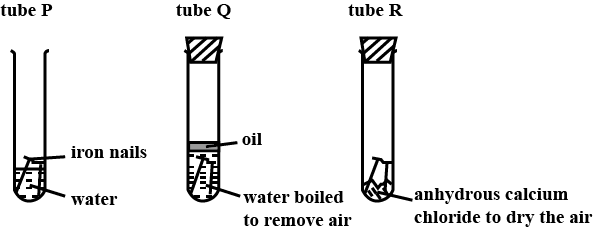
Answer
441k+ views
Hint: Iron is a chemical element represented by Fe which Fe stands for ferrum which is a Latin word and the atomic number of Fe is 26. This metal belongs to group 8 of the periodic table and kept in the category of transition elements because it contains d subshell.
Complete step by step answer:
- Rusting generally acts on the surface of iron due to which the surface becomes dull. This can be explained by the most reactive nature of iron. Iron reacts with oxygen present in air and forms oxides due to which it gets corroded. The conditions necessary for rust are water and oxygen present in the environment.
- In the given cases tube P is open so it has both conditions of rusting water as well as environmental oxygen so the nail present in tube P will develop rust, In case Q we can see that tube is covered with cork so no oxygen is present therefore iron will not develop rust and the nail in tube Q do not rust similarly tube R is also closed therefore no supply of oxygen and the nail in R also not produce any rust. The correct answer is option “D” .
Note: Some metallic objects develop a change on their surface with the passage of time or we can say that they are kept unused for a long time this change is due to the chemical reactions proceeding by them in the environment and this process is known as corrosion.
Complete step by step answer:
- Rusting generally acts on the surface of iron due to which the surface becomes dull. This can be explained by the most reactive nature of iron. Iron reacts with oxygen present in air and forms oxides due to which it gets corroded. The conditions necessary for rust are water and oxygen present in the environment.
- In the given cases tube P is open so it has both conditions of rusting water as well as environmental oxygen so the nail present in tube P will develop rust, In case Q we can see that tube is covered with cork so no oxygen is present therefore iron will not develop rust and the nail in tube Q do not rust similarly tube R is also closed therefore no supply of oxygen and the nail in R also not produce any rust. The correct answer is option “D” .
Note: Some metallic objects develop a change on their surface with the passage of time or we can say that they are kept unused for a long time this change is due to the chemical reactions proceeding by them in the environment and this process is known as corrosion.
Recently Updated Pages
How is abiogenesis theory disproved experimentally class 12 biology CBSE

What is Biological Magnification

Explain the Basics of Computer and Number System?

Class 11 Question and Answer - Your Ultimate Solutions Guide

Write the IUPAC name of the given compound class 11 chemistry CBSE

Write the IUPAC name of the given compound class 11 chemistry CBSE

Trending doubts
Who was the Governor general of India at the time of class 11 social science CBSE

Difference between Prokaryotic cell and Eukaryotic class 11 biology CBSE

State and prove Bernoullis theorem class 11 physics CBSE

Proton was discovered by A Thomson B Rutherford C Chadwick class 11 chemistry CBSE

What organs are located on the left side of your body class 11 biology CBSE

10 examples of friction in our daily life





